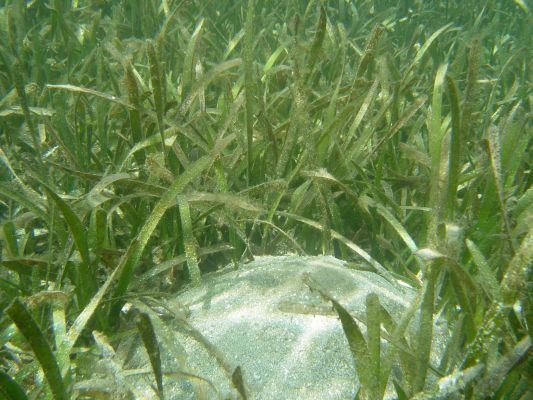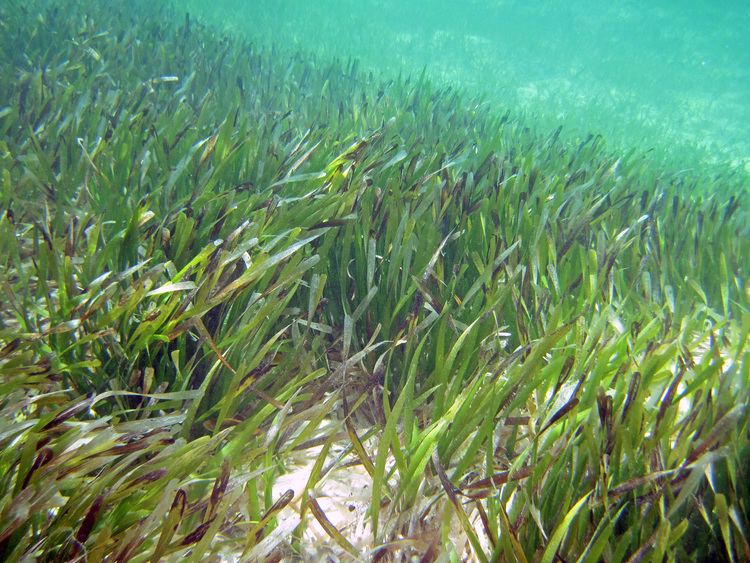Rank Species | ||
 | ||
Similar Thalassia, Syringodium filiforme, Halodule, Syringodium, Halodule wrightii | ||
Thalassia testudinum, commonly known as turtlegrass, is a species of marine seagrass. It forms meadows in shallow sandy or muddy locations in the Caribbean Sea and the Gulf of Mexico.
Contents

Description

Thalassia testudinum is a perennial grass growing from a long, jointed rhizome that may be buried 25 centimetres (9.8 in) deep in the substrate but is more usually found 5 to 10 cm (2 to 4 in) below the surface. Some nodes are leafless but others bear a tuft of several erect, linear leaf blades. These are up to 30 centimetres (12 in) long and 2 cm (0.8 in) wide and have rounded tips. The flowers grow on short stalks in the axils of the leaves and are greenish-white, sometimes tinged pink, and are followed by seed pods.
Distribution and habitat
Turtle grass is found growing in meadows in calm shallow waters throughout the Caribbean Sea and the Gulf of Mexico and as far north as Cape Canaveral in Florida. Extensive meadows can be formed on muddy sand, coarse sandy and clayey seabeds, especially those with a calcareous content. This grass favours high-salinity waters with low turbidity such as calm lagoons. It cannot grow in fresh water but some growth is possible at a salinity of 10 parts per thousand. The plant's preferred range is 25 to 38.5 parts per thousand with a temperature range of 20 to 30 °C (68 to 86 °F). It is found from low-tide mark down to depths of 30 metres (98 ft) depending on water clarity. It often grows in meadows with other seagrasses where it is the climax species.
Reproduction

Turtle grass can reproduce both vegetatively and by sexual reproduction. The main propagative method is by increase in length of the rhizomes. This mainly takes place in spring and early summer but can happen at any time of year and results in an increase in the size of the turtle grass bed. It has been found that where plants have been damaged mechanically, such as by the propellers of boats, the cut ends of rhizomes are unable to grow and holes may develop in the turtle grass meadow.
Unusually for the marine environment, turtle grass is a flowering plant. In the spring and early summer, many turtle grass plants produce small flowers at the base of the leaves. Male and female flowers grow on separate plants. Fruits develop in two to four weeks and became detached and float away after about eight weeks.
It has been recently discovered that zooplankton acts as a pollinator for turtle grass. Plankton is drawn to the seagrass’s nutritious mucilage—a carbohydrate-rich substance that houses pollen. As the plankton feeds on the mucilage, excess pollen grains stick to their bodies. Plankton then moves from seagrass to seagrass feeding and spreading the pollen.
The seeds are viviparous, and can start new patches of seagrass, but it is thought that the main method of reproduction is vegetative.
Ecology
Turtle grass and other seagrasses form meadows which are important habitats and feeding grounds. Associated seagrass species include Halophila engelmannii and Syringodium filiforme. Many epiphytes grow on the grasses, and algae, diatoms and bacterial films cover the surface of the leaf blades. The grass is eaten by turtles, herbivorous parrotfish, surgeonfish and sea urchins while the leaf surface films are a food source for many small invertebrates. Decaying turtle grass leaves are responsible for the majority of detritus in meadow areas. This grass is subject to periodic dieback episodes in the Florida Bay area. One such episode in 1987 killed off a large proportion of the plants and the resulting increased sedimentation and greater growth of epiphytes on the remaining plants caused a secondary dieback event. The areas affected have since been reseeded and planted with rhizomes and have recovered. In general, the population of this grass is stable.
Rhizomatous green algae in the genus Caulerpa often live among the grasses and many animals make seagrass meadows their home. These include bivalves and other molluscs, polychaete worms, amphipods and juvenile fish which hide among the leaf blades, sea urchins, crabs and caridean shrimps.
